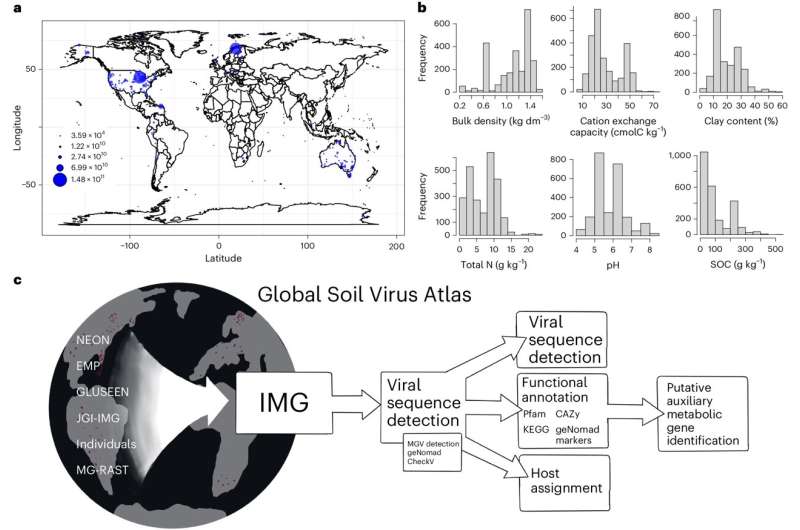This article has been reviewed according to Science X's editorial process and policies. Editors have highlighted the following attributes while ensuring the content's credibility:
fact-checked
peer-reviewed publication
trusted source
proofread
Comprehensive, first-ever soil virus dataset represents untapped viral diversity, biogeochemical potential

Soils are among the largest viral reservoirs on Earth. Yet historically, soil viruses have been ignored. Recent work indicates the soil virosphere as a critical factor in human and environmental health, yet our understanding of global soil viral distributions, activities, and interactions with the soil microbiome remains limited.
In a new study published in Nature Microbiology, scientists coordinated a global consortium, representing nearly 50 organizations worldwide, to generate the first-of-its-kind Global Soil Virus (GSV) Atlas. This compilation of soil viral genomes provides a comprehensive description of the soil virosphere, its potential to impact global biogeochemistry, and an open database for future investigations of soil viral ecology.
The GSV Atlas is a comprehensive collection of genomic information from 2,953 soils from around the planet, including 1,552 samples that were unavailable previously. The GSV Atlas is composed of 616,935 uncultivated viral genomes that have never been grown in the lab.
The Atlas groups the genomes into species-like entities and describes their possible roles in global biogeochemistry. It includes a wide array of microbial hosts of soil viruses, key functions associated with soil carbon cycles, and viral metabolisms that may be critical to understanding soil ecology.
Underscoring the diversity of the soil virosphere, 95.8% of viral genes lacked a known function, and only 2.78% of viral sequences were matched to a host organism. Given the large amount of soil viral "dark matter" (genes for which no function is known), this study and the GSV Atlas provide a much-needed community resource to facilitate further investigations into the soil virosphere.
The researchers have highlighted promising areas for further investigation, including (1) large changes in viral communities across short distances, (2) diverse microbial hosts that are important for soil biogeochemistry, and (3) specific viral genes involved in carbon cycling and other growth strategies.
By providing the GSV Atlas as a new public resource, we are encouraging the scientific community to generate and test hypotheses that will advance the resolution of pressing challenges in viral ecology such as disease emergence, vaccine failure, and drug resistance.
More information: Emily B. Graham et al, A global atlas of soil viruses reveals unexplored biodiversity and potential biogeochemical impacts, Nature Microbiology (2024). DOI: 10.1038/s41564-024-01686-x
Journal information: Nature Microbiology
Provided by Pacific Northwest National Laboratory




















